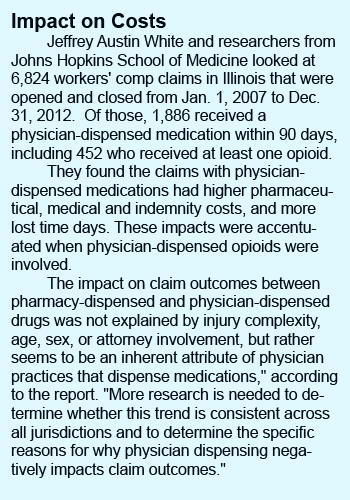Pharmacy Management
Physician-Dispensed Opioids Double WC Costs, Days Off

Medical and indemnity costs as well as days lost from work are significantly higher when physicians dispense medications to injured workers, suggests a new study. The effect is doubled when opioids are involved.
The findings, published in the Journal of Occupational and Environmental Medicine, are based on a sample of nearly 7,000 Illinois workers’ comp indemnity claims by Accident Fund Holdings (see box). They represent the first scientific peer-reviewed journal article to link poor outcomes in claims to physicians dispensing opioids.
“We found in Illinois that medical costs for claims where drugs were dispensed by a physician were 39 percent higher, indemnity costs were 27 percent higher, and days off work were 34 percent higher than in claims where drugs were dispensed by pharmacies,” said Jeffrey Austin White, director of medical management practices and strategy, corporate claims, for Accident Fund Holdings. “More striking was the effect of opioids where each of those metrics was doubled … 78 percent higher medical costs, 57 percent higher indemnity costs, and 85 percent increase in lost time cost.”
White, who conducted the study in collaboration with researchers from Johns Hopkins School of Medicine, hopes the research will be a tool to help improve the situation. Several states had requested advance copies of the study to aid in legislative decision-making on the issue.
“Widespread adoption of laws limiting the reimbursement of physician-dispensed drugs across the country would reduce abuse, dependency, over utilization, drug spend, and overall claim cost for injured workers affected by this practice,” White said. “I am hoping this research helps drive legislative changes across the country to deter this behavior and improve the safety of our injured workers.”
The Study
The report, Effect of Physician-Dispensed Medication on Workers’ Compensation Claim Outcomes in the State of Illinois, builds on previous research from White, as well as a study by the California Workers’ Compensation Institute. The CWCI found similar cost increases in California for physician-dispensed medications compared with those dispensed by a pharmacy. White’s team had previously found that claims costs in Michigan increased as higher doses of opioids were included.
“There’s always been a question as to whether physician dispensing is negatively affecting claims outcomes,” White said. “We knew there was a correlation in California, and thought, wouldn’t it be nice to duplicate that study in Illinois and up the ante by looking at physician dispensing of opioids.”
 With an estimated 70 percent of injured workers prescribed opioids in their book of business, the issue is a concern. The fact that one in four drugs paid by Accident Fund comes directly from the physician’s office is even more troubling.
With an estimated 70 percent of injured workers prescribed opioids in their book of business, the issue is a concern. The fact that one in four drugs paid by Accident Fund comes directly from the physician’s office is even more troubling.
“The way physician-dispensed drugs are being billed is in paper form, so it’s taking several weeks to arrive at our facility for review,” White explained. “It is bypassing the pharmacy benefit management formulary, bypassing our early detection solution which monitors in real time for abnormal patterns. So clearly one-quarter of the scripts are coming by ways we can’t effectively monitor and intervene in a timely fashion.”
White believes the current billing mechanism and the delays in processing may be the reason for the significantly poorer outcomes in claims where medications, especially opioids, are dispensed directly from physicians. As he said, control is lost when medications are dispensed through a physician’s office.
Loss of Control
“When a drug is dispensed at a pharmacy, there are a lot of checks and balances in consideration of the evidence-based medicine guidelines. There is a safety protocol around it,” White said. “When it is physician dispensed, it bypasses all those controls … control over the dosage and frequency; we can’t address drug interactions.”
That can lead to claims deteriorating before the first bill even arrives. By that time, the damage is already done.
“Based on our research we know the most effective way of handling this is early detection and early intervention within the first few days versus several months down the line or several years down the line,” he said. Without that, “it doesn’t give us the opportunity to contact the physician or the patient to make sure [the patient] has had the proper education around the use of the drug.”
Government Interest
Meanwhile, White and his colleagues are trying to catch the attention of state and federal lawmakers to address the whole issue of physician dispensing. For example, they raised the issue during a recent meeting with a Food and Drug Administration panel.
“Our ultimate goal is to impact availability and put more controls in place and education around the use of opioids,” he said. “Working at the state and federal levels is slow, but it’s important that we get more involved in this, especially considering our research findings.”










